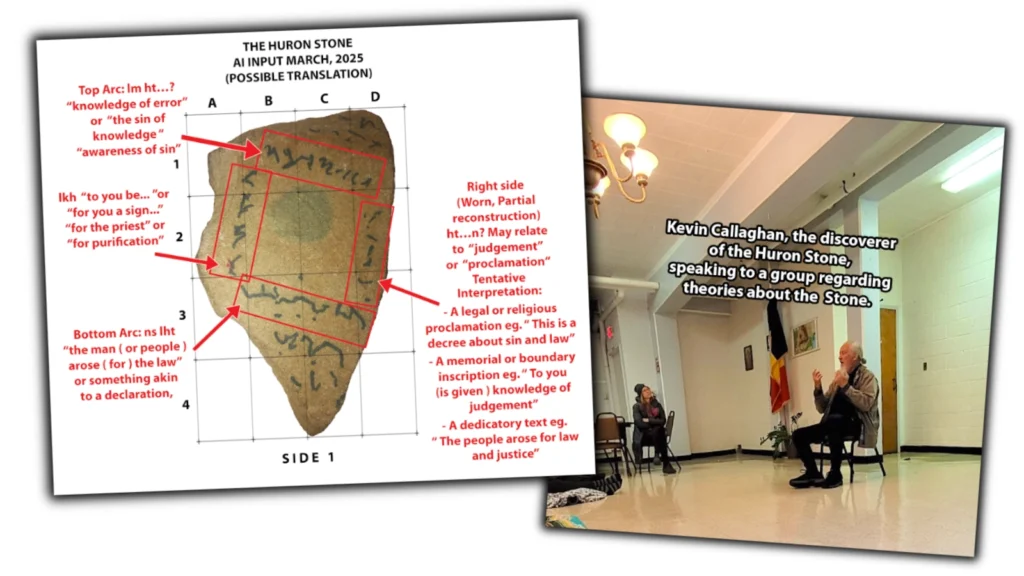Michigan’s Huron Stone: Ancient Enigma or Modern Mystery? A Tale of Discovery and AI Insights
Unearthed from murky depths, the Huron Stone’s cryptic markings could rewrite history—is it a relic of forgotten explorers? 🌐 #News #DetroitMI #Michigan #History
DETROIT, MI — Picture this: a crisp Michigan day in 2006, the waters of Lake Huron lapping gently at the shore, and a father skipping stones with his daughters. What started as a simple outing turned into one of the most tantalizing mysteries in North American archaeology. Kevin Callaghan, the man behind the discovery of the Huron Stone—a peculiar rock adorned with cryptic markings—has spent nearly two decades chasing answers.
As I wrote in my original article, The Huron Stone: Did Ancient Explorers Leave This Mysteriously Marked Rock in Michigan?, this enigmatic find sparked speculation about ancient explorers, Michigan’s copper trade, and even Phoenician voyages to the Great Lakes.
This month, explosive updates fueled by AI analysis and plans for radiocarbon dating have thrust the Huron Stone back into the spotlight. With exclusive insights from Kevin and his great-nephew Seamus Callaghan, a Stanford PhD student, this is a story that will leave you spellbound.
The Discovery That Started It All
Kevin Callaghan’s journey began on the shores of Lake Huron during a day of low water levels in 2006. While searching for smooth stones, he noticed one that seemed out of place.
“I almost tossed it back into the water,” Kevin recalls, “until I saw what looked like carvings on its surface.” Urged by his daughters to flip it over, he uncovered intricate designs that launched a quest spanning years.
Initial consultations with experts at the Cranbrook Science Center and Michigan State University, as well as inquiries with Indigenous representatives, yielded fascination but no clear answers. Tests on the stone’s sandstone composition hinted at similarities to lapis, a stone revered by ancient cultures, but the “ink” forming its markings remained elusive.
Theories ranged from ancient artifacts to clever hoaxes, yet, as I noted, the Huron Stone remained an unsolved puzzle—until now.

AI Unveils a Semitic Connection
Enter Seamus Callaghan, Kevin’s great-nephew and a paleontologist-in-training at Stanford.
In March 2025, Seamus harnessed the power of AI to analyze the stone’s inscriptions, and the results are nothing short of astonishing.
“I told [the AI] I had an image of a rock with writing on it and asked it for help identifying the script,” Seamus explains.
Without any prompting about Phoenicians, the AI zeroed in on ancient Semitic scripts, including Phoenician (1200–150 BCE), Aramaic, Syriac, and Nabataean (200 BCE–700 CE).
Kevin, thrilled by the findings, shares, “Without suggesting Phoenician script, AI came up with Phoenician or something close like Nabataean and Aramaic. We have a few contacts (non-AI) that have independently come up with the same conclusion.”
The AI’s analysis is a game-changer.
It noted the right-to-left text flow, angular characters with curves, and specific resemblances to letters like Aleph (a sideways “A”) and Mem (a wave-like “m” with a tail). When Seamus flipped the image upside down, the AI detected cursive elements suggestive of Nabataean or later Aramaic influences.
The inscriptions, potentially encoding a name, dedication, or religious phrase, could reference AL-Lat, a Nabataean goddess. Tentative translations include evocative phrases like “knowledge of sin,” “for the priest,” or “the people arose for law and justice.”
The stone’s dual-sided, square-enclosed inscriptions, arranged in a circular structure, suggest a ritualistic purpose—perhaps a decree, memorial, or boundary marker.
“The square arrangement suggests a deliberate stylistic choice, possibly indicating an inscription with a formal or ritual purpose,” the AI observed, as Seamus notes.
The Ink’s Ancient Secrets
The updates also shed light on the stone’s material properties, deepening the intrigue. Elemental analysis revealed the “ink” has high carbon content, consistent with ancient carbon-based inks used in Egyptian papyri, medieval manuscripts, and Indigenous American traditions.
“Carbon-based ink has been used in many historical texts,” the AI reported, suggesting the inscriptions could be millennia old.
Seamus is cautious. “Carbon is a common element in many inks, both ancient and modern, so the AI’s commentary on various ancient carbon-based inks isn’t necessarily meaningful,” he said.
Kevin is particularly curious about the ink’s blue hue, saying, “We have more questions for AI—like why is the ‘writing’ blue and how does it interpret some test results we have on the chemical makeup of the ‘ink.’”
The stone’s uneven wear, likely from prolonged exposure to Lake Huron’s waters, further supports its antiquity, as modern graffiti typically uses markers or paint that erode differently.

Lake Huron’s Ancient Trade Routes
The Huron Stone’s discovery in Lake Huron, a hub of ancient trade routes, fuels speculation about its origins. As I highlighted in my original article, Michigan’s ancient copper mines have long been tied to theories of pre-Columbian contact, with some positing Phoenician or other seafaring cultures as visitors.
The AI’s identification of Semitic scripts strengthens this hypothesis.
Could the stone be a relic of traders, explorers, or missionaries? Or does it hint at an unknown local tradition influenced by distant cultures?
The stone’s ritualistic design and possible religious inscriptions suggest it might have marked a sacred site or trade item, aligning with Nabataean practices.
“Lake Huron has ancient trade routes,” the AI noted, prompting Kevin to wonder, “Could [it] have been brought over by explorers, traders, or settlers?”
The Road Ahead: Radiocarbon Dating and Beyond
The next steps are as thrilling as the discoveries so far.
Seamus, cautious yet optimistic, emphasizes the need for hard data: “An elemental analysis of the ink revealed that it contains carbon, so I think the key next step should be to try and get a radiocarbon date on the text. That would tell us whether we’re looking at a genuine ancient artefact or something made more recently.”
Kevin echoes this, adding, “We are also in the process of identifying a lab or facility that can determine the age of the ink and what was used to apply it to the stone.”
Additional tests, including UV or infrared imaging and comparisons with other Lake Huron artifacts, could confirm whether the stone predates European settlement, potentially rewriting North America’s history.
If ancient, the Huron Stone could be “one of the most mysterious artifacts found in North America,” as the AI suggested. If recent, the question remains: who crafted it, and why?

A Challenge to History
As I noted in my original article, Kevin suspected academia’s reluctance to embrace the Huron Stone stemmed from its challenge to established narratives. The idea of ancient Semitic explorers reaching North America remains controversial, yet the AI’s impartiality offers fresh credibility.
Seamus reflects, “Sometimes AI provides good information, sometimes it makes mistakes, and sometimes it lies on purpose. Everything it says should be taken with a grain of salt. At least its biases are different from those of human researchers, who all too often have egos and ideologies invested in particular outcomes.”
Kevin agrees, praising Seamus’s approach: “Having Seamus as the moderator was critical. Seamus was very selective and patient with his questions.”
This objectivity, combined with growing evidence of transoceanic contact, positions the Huron Stone as a potential key to forgotten histories.
Join the Quest
The Huron Stone is no longer a local oddity here in Michigan—it’s a global mystery that demands exploration. Kevin’s determination and Seamus’s innovative AI analysis have transformed this artifact into a beacon for historians, archaeologists, and curious minds.
“I choose to be neutral in my opinions of the stone’s origins until some hard scientific data points us in a particular direction,” Seamus says, adding, “I hope it does turn out to be ancient. That would certainly be the most interesting outcome.”
Will radiocarbon dating confirm an ancient origin, linking Michigan to distant civilizations? Or will it reveal a modern enigma with its own tale?
Visit Kevin’s website here to learn more and share your theories. The Huron Stone beckons us to question the past and embrace the unknown—because, as Kevin and Seamus remind us, the greatest discoveries often start with a single, unexpected find.

